A Theatre Dictionary for Newcomers
Guest blogger Samantha Belding has been participating in Center Stage PYT shows since 2015 (Les Miserables). She has written a PYT theatre dictionary to help newcomers understand the “theatre lingo.”
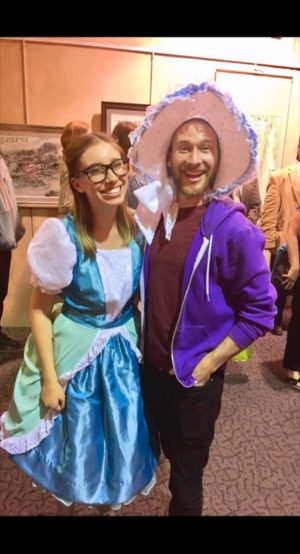
Samantha with Cinderella Director Brian Miller!
Theatre Dictionary
You’ll never find a real theatre person who spells theatre, “theater”
Casts: The two groups of actors that perform in the show. For example, our two Cinderella casts were “Hijinks” and “Shenanigans.”
Stage Manager: The person who runs the show from opening curtain to closing curtain and is in charge of everything on the stage and backstage. The stage manager can help you with any technical questions, but if she is busy, you can ask her ASMs.
ASM: ASM means Assistant Stage Manager. They are always available to answer your questions in rehearsal, however, toward the end of tech week and during the performances, they will be backstage and extremely busy.
Dressers: Dressers are the people who help the actors get into and out of their costumes during performances. They are usually responsible for helping actors with quick changes.
Quick change: In a quick change, an actor changes costumes very quickly and sometimes requires the help of dressers, sometimes even in the wings.
Backstage: Backstage is the part of the theatre which is not seen by the audience. This includes the wings, the dressing rooms, and the green room.
Wings: The wings are the sides of the stage where sets are kept, quick changes happen, and actors wait to come on stage. Make sure to always stay behind the sight lines!
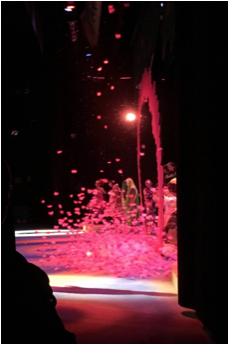
A View of Seussical from the Wings
Sight Lines: Sight Lines are bright lines of tape that show where you should stand behind. If you can see the audience, the audience can see you!
Dressing Rooms: Dressing rooms are rooms provided for the actors where they keep their costumes and props. They also use dressing rooms to change in and out of costumes during the show. This is also a good place to apply stage makeup if you didn’t apply it before you came to the theatre. No one ever receives his or her own dressing room, so you have to learn how to share space with your cast mates.
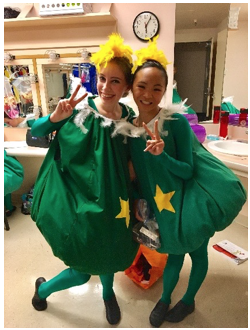
Samantha and Nally in the Dressing Room during Seussical
Green Room: The Green Room is a large room backstage that actors hang out in when they’re not on stage during performances. There are fun activities like board games, card games, and coloring. This is also the place where you get your character makeup if you need it. There are usually a lot of people on staff that can help you, so the Green Room is the place to go if you have any questions.
Stage makeup: Stage makeup is what every actor must wear during all performances and dress rehearsals in the theatre.
Character makeup: Character makeup is specialized makeup for a specific character.
The House: The house is where the audience sits in the theatre. During tech week, the cast spends a lot of time waiting in the house. The director will say things like, “After dinner, sit quietly in the house.”

Dress Rehearsal for Annie
Aisle: The aisle is a passage that goes in between the seats of the house. Sometimes, the actors exit or enter through the aisles.
The Orchestra Pit: The orchestra pit, sometimes referred to as “the pit,” is a small room underneath the stage where the orchestra and conductor work. There is a hole in the stage where the conductor stands. He tells you when to begin and end a song if you need help.
Props: Props are objects that are used in the show, such as a picnic basket or a magic wand. Never touch any of the props unless you have to use them in the show because they can be difficult to replace if broken.
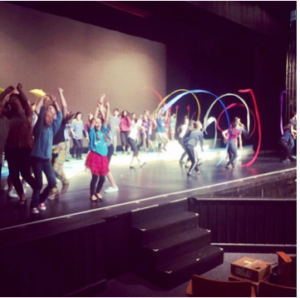
The Opening Number of Seussical with Props.
Downstage: Downstage is located toward the front of the stage, near the audience.
Upstage: Upstage is located toward the back of the stage, away from the audience.
Stage Left: Stage left is the left side of the stage from the actor’s perspective.
Stage Right: Stage right is the right side of the stage from the actor’s perspective.
Sets: The sets are big walls, stairs, and other objects and structures that are moved around on stage to create a scene. The sets are stored in the wings when they aren’t on stage, so you have to be extra careful when waiting in the wings.
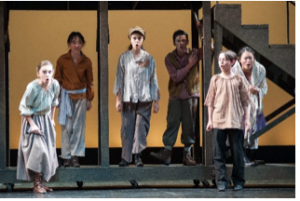
Cast Members Moving the Set Pieces during Les Miserables
Director: The director is in charge of the show. This person has creative control and is allowed to boss actors around.
Choreographer: The choreographer is in charge of the dancing. They plan out (choreograph) and teach every dance to the actors.
Vocal Director: The vocal director is in charge of the singing. They teach every song to the actors and give them vocal direction.
Blocking: How and where the actors move around on stage during a performance

Dress Rehearsal for Once Upon A Mattress
Something you NEVER say in a theatre: In theatre, people can be very superstitious, and the worst possible thing to say inside of the theatre is the word Macbeth. Most people refer to it as, “The Scottish Play” because they don’t want to say the actual name. In the play, Macbeth, many terrible things happen, so actors believe that if you say this name in a theatre, the show will be cursed. Even if you don’t believe in this superstition, be prepared to see a lot of angry actors in your face, frantically trying to undo the curse, if this word is spoken!
I hope this little theatre primer was helpful to new actors at PYT. Break a leg, everyone! (P.S. “Break a leg” is the theatre term for “good luck”).







